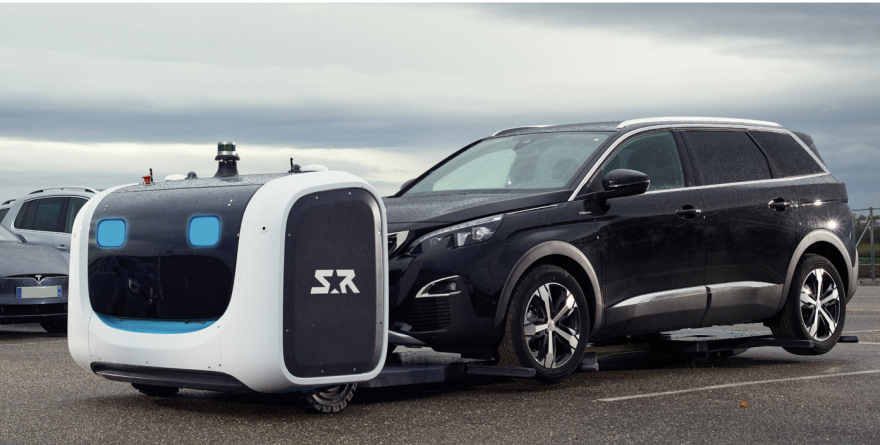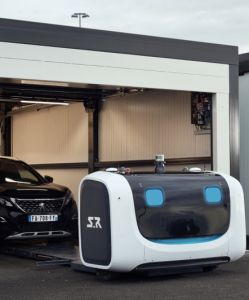
Stan, the parking robot. Photo Stanley Robotics.
Stan, a fully autonomous outdoor parking valet, is now operational at select airports in Europe. The robot uses GNSS, LiDAR and cameras to move cars into storage places with requisite centimeter-level accuracy, including transition from outdoor to indoor.
A Trimble BX992 multi-frequency GNSS rover receiver with precise heading capability rides inside the robot and two antennas Trimble AV59 GNSS Antennas atop its head, with maximum separation between them. To attain the centimeter-level localization, a Trimble BX992 base and a Trimble Zephyr Antenna stand at the drop-off cabins where customers drop off their cars. The Trimble BX992 base broadcasts RTK corrections over a WiFi link to the robots.
Stan also employs two LiDAR scanners and four cameras. LiDAR-based simultaneous localization and mapping (SLAM) techniques help to locate the robot and build a map. The LiDAR-based SLAM system is always running and
fused with the GNSS localization and odometry.

Stan roves. Photo Stanley Robotics.
“The LiDAR is mostly critical in the cabins where the GNSS availability and reliability is not sufficient,” said Anthony Troublé, robot team manager at Stanley Robotics. “The full integration with our localization system, especially the transition from indoor-to-outdoor when the robot enters a cabin was a challenge. We have tuned and improved our localization fusion algorithm to get the best out of each component and deliver a consistent confidence index.”
The company begins by evaluating the existing car park scope and scale. Historical parking data is compiled over the preceding 12 months and run through a simulator together optimize the number of robots and cabins needed. Once operational, robot creates its own map in real-time for every mission by scanning vehicles and adjusting the dimensions of its ramp, which supports and transports the car. When ready, Stan clamps onto the vehicle wheels and navigates with GNSS and LiDAR from a cabin to a designated parking space for drop-offs, and vice versa when the customer returns.

Stan gets in. Photo Stanley Robotics.
Stanley Robotics continuously monitors the accuracy, availability and consistency of the RTK GNSS, SLAM and odometry localization signals. “If these signals are too inconsistent or if the overall confidence is too low, the robots are stopped and a site supervisor is alerted,” said Troublé. “Further, the site is monitored through LiDARs and cameras on the robot to prevent any collision with obstacles.”
The first outdoor car park managed by robots opened to the public in 2018 in Lyon, France. Four Stan robots are now fully operational in Lyon Saint-Exupéry airport car park, which can accommodate up to 500 vehicles. Stanley Robotics will open 2,000 spaces at Lyon in the summer of 2020. The airport seeks to expand this system to up to 6,000 spaces. Last year, Stanley Robotics signed a contract with Gatwick Airports in the UK.
Founded in 2015, Stanley Robotics is headquartered in Paris.

Stan alone. Photo Stanley Robotics.

